Poznań 2025-08-28
InterCity train “Ślązak” Poznań Główny – Przemyśl Główny.

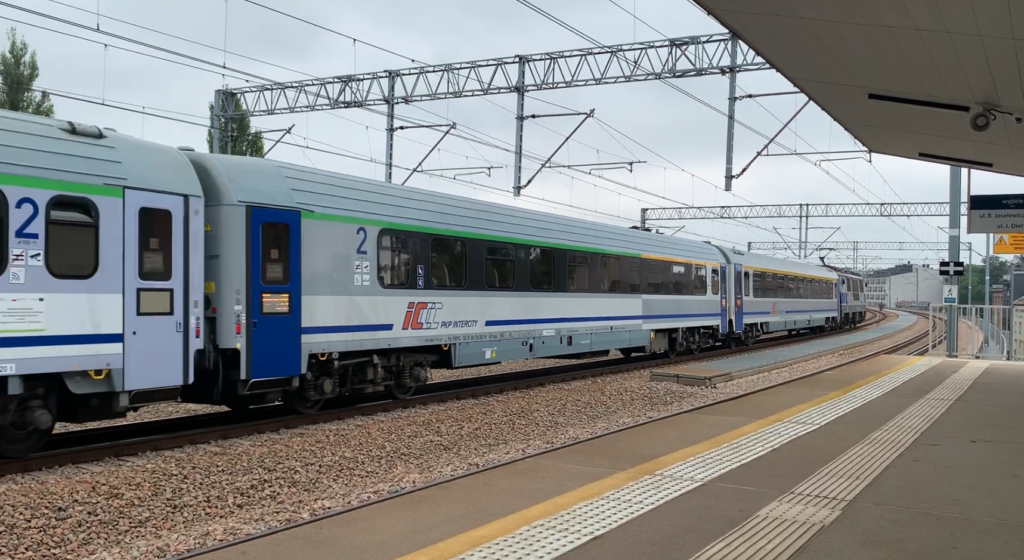
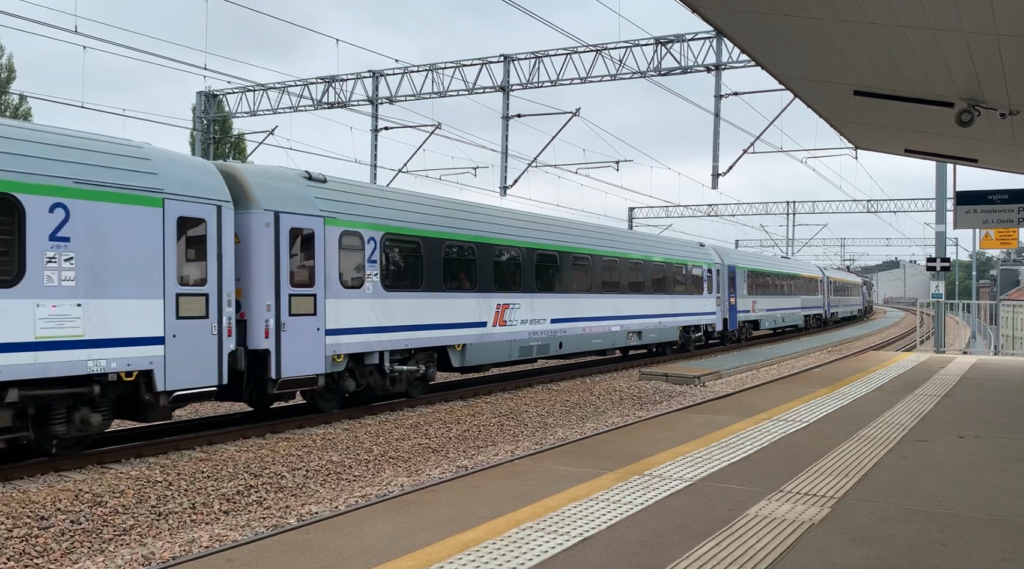
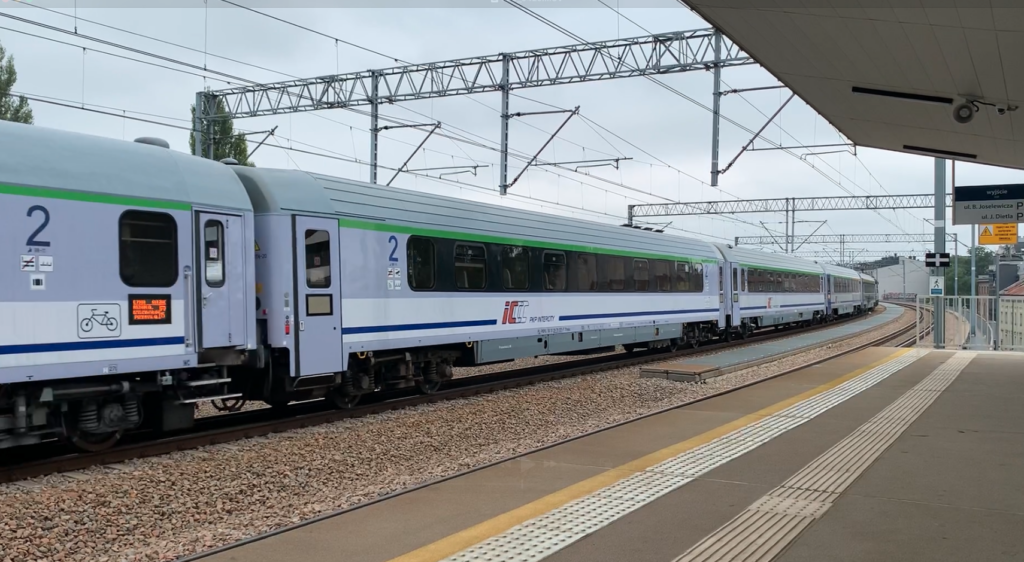
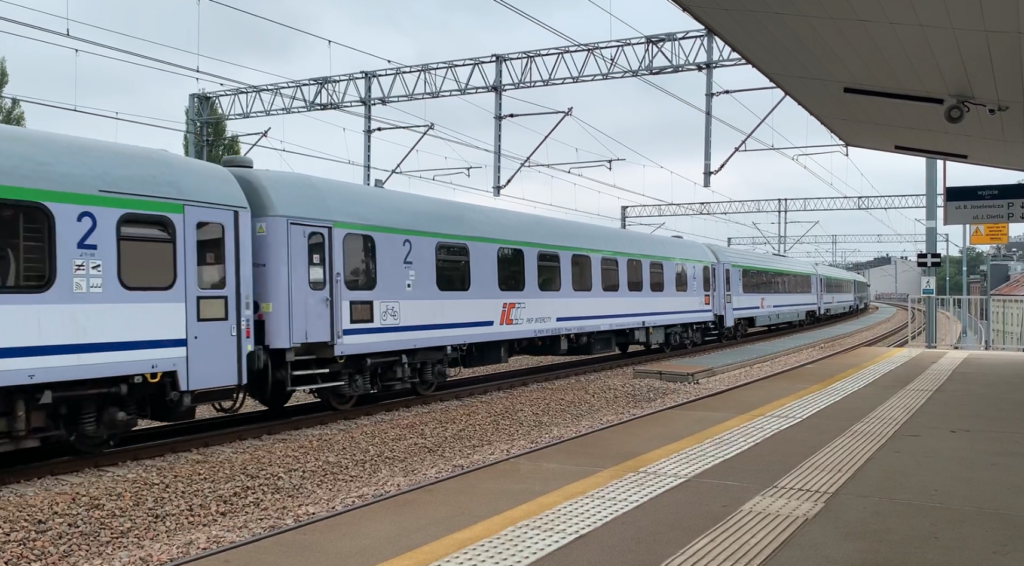
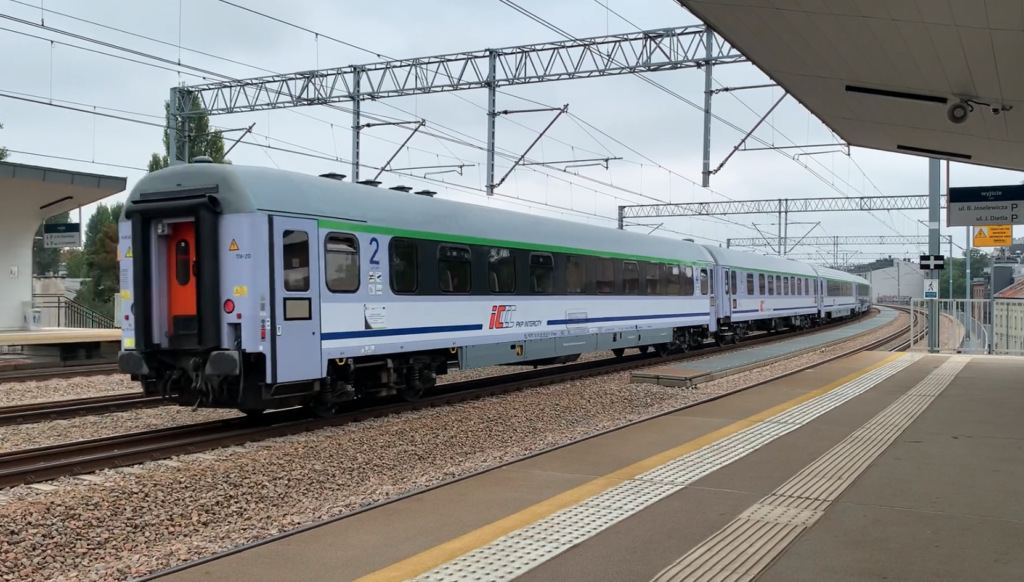
PKP InterCity.
PKP InterCity is a Polish rail carrier belonging to the PKP Group. It provides long-distance passenger transport. In Poland, it accounts for 15% of passenger transport in terms of passenger numbers, but 53% in passenger-kilometer travel. The company was founded on August 30, 2001, employing 1,500 people. Currently (2024), it employs 8,936 people. The company transports passengers under the Express Intercity, Express Intercity Premium, and TLK brands. Under the former brand, it uses electric and diesel locomotives with classic carriages, as well as multiple unit trains (EMUs). Under the Express Intercity Premium brand, it operates 20 ED250 Pendolino multiple unit trains (EMUs).
Initially, its competitor was Przewozy Regionalne, which transferred its express trains to InterCity in 2008. At that time, some of the rolling stock and employees were transferred to InterCity. With the introduction of the ED250 Pendolino EMU trains, the company began generating a profit. Pendolino trains are serviced at Warsaw Grochów station.
In December 2014, after years of trials, the InterCity long-distance train category was established. These trains were reinforced with new purchases. The Flirt and Dart EMUs were purchased, with a cruising speed of 160 km/h. The electric locomotives were overhauled and modernized, some of which were adapted to a cruising speed of 160 km/h. Many “Y” series carriages underwent extensive overhauls and modernization. The renovations also affected the restaurant and bar carriages. The company also operates sleeping and couchette carriages. Since 2010, postal carriages have no longer been used in Poland.
InterCity Rolling Stock.
Initially, InterCity did not have its own locomotives, as all of them had been transferred to PKP Cargo. This proved to be a poor solution. Therefore, the company gradually acquired new or modernized electric and diesel locomotives. In 2008, the company purchased 10 Eurosprinter ES64U4 Taurus multi-system electric locomotives to operate international trains.
In 2009, InterCity had the following locomotives: 1 EP05, 157 EP07s, 169 EU07s, 9 EP08s, 47 EP09s, 50 SM42s (SP42s), and 19 SU45s. In 2014, 10 SU160 Gama locomotives and 20 SM42-1000 Newag locomotives were purchased.
In 2020, Olkol refurbished 23 electric locomotives to the EU07A standard. Among other things, the electric motors were replaced with asynchronous ones. Locomotive speed increased from 125 km/h to 160 km/h.
In 2010, InterCity had 3,131 cars. By 2015, the company had modernized 218 cars. The refurbishments were performed by Polish companies: HCP (FPS – Fabryka Pojazdów Szynowych), Pesa Bydgoszcz, Newag Nowy Sącz, and ZNTK “Mińsk Mazowiecki.” By 2015, 54 new cars had been purchased. Between 2016 and 2018, another 176 cars of the 111A, 141A, 144A, and 145A series were refurbished.
In 2018, InterCity ordered 81 new railcars from Fabryka Pojazdów Szynowych (HCP). In April 2018, InterCity ordered the refurbishment of 70 type 111A, 112A, and 140A railcars. In 2019, a contract was signed for the refurbishment of another 10 type 145Ab railcars to restaurant car standard. In August 2019, another 12 eight-car Flirt EZTs were ordered from Stadler.
In 2021, InterCity had the following electric locomotives: 1 EP05 (speed of 160 km/h), 227 EU07s, EP07 (speed of 125 km/h), 1 EP05 (speed of 160 km/h), 23 EU07A (speed of 160 km/h), 9 EP08s (speed of 140 km/h), 46 EP09 (speed of 160 km/h), 10 EU44 Husarz (speed of 230 km/h), 30 EU160 Griffin (speed of 160 km/h). Ten NEWAG E4MSUa multi-system locomotives with a maximum speed of 200 km/h have been ordered for international trains. The first locomotives of this type were delivered in 2024 and were designated EU200 (maximum speed 200 km/h).
In 2021, InterCity operated the following diesel locomotives: 17 SM42 (6D) locomotives, capable of speeds of 90 km/h; 10 SM42 (18D) locomotives, capable of speeds of 90 km/h; 17 SM42 (6D) locomotives, capable of speeds of 90 km/h; 10 SU42-1000 (6DI) locomotives, capable of speeds of 90 km/h; and 10 SU160 Gama (111Db) locomotives, capable of speeds of 140 km/h. Ten SM42-2000 (6D-FPS) locomotives, capable of speeds of 90 km/h, have been ordered. Of these locomotives, the SU160 Gama is the best, having duly replaced the SU45 and SU42-1000 locomotives, which are ideal for short passenger trains.
Currently, in 2021, InterCity has the following EMUs: 20 ED250 Pendolino trains, 7-carriage, with a maximum speed of 250 km/h; 32 ED160 Flirt trains, 8-carriage, with a maximum speed of 160 km/h; and 20 ED161 Dart trains, 8-carriage, with a maximum speed of 160 km/h. InterCity also has four ED74 Bydgostia trains, 4-carriage, which, for various reasons, have not entered permanent service. They are currently being rebuilt and should enter service in 2022.
As of January 1, 2024, PKP Intercity had 226 operational locomotives. Of these, 93 were approved for operation at speeds above 150 km/h. Electric locomotives; In stock were: EP05 (1), EU07 (175), EU07A (3), EP08 (9), EP09 (41), EU44 Husarz (10), EU160 Griffin (81 of 96 ordered), EU200 Griffin (15 of 78 ordered).
Diesel locomotives: SM42 6D (17 units), SM42 18D modernized (10 units), SU42 6DI Newag modernized (10 units), SU160 Gama (10 units), SM60 EFIShunter 300 (10 units), 754 ČD Nurek series (3-7 units on loan).
Electric locomotives: ED74 Edyta (14 units), ED160 FLIRT3 (32 units), ED161 Pesa Dart (20 units), ED250 Pendolino (20 units). A total of 86 electric multiple units. On average, approximately 10 electric multiple units are undergoing maintenance.
Passenger service.
In 2001, the carrier launched online ticket booking. In 2005, online ticket sales were launched. Seating was determined by a system. Later, the option of choosing a limited seat: window or aisle seat was introduced. In 2009, the carrier began selling tickets through ticket machines. In 2014, the carrier began selling tickets via mobile phones via the SkyCash mobile app. In 2015, ticket sales began at selected Polish Post offices. In 2017, online ticket sales with a single transfer were launched. Until then, tickets had to be purchased separately. Since 2021, passengers have been able to select a specific seat online.
In 2014, mobile internet access was introduced on some trains, but for a limited period (10 minutes of access after logging in). In 2015, access to multimedia websites was introduced, including through a partnership with Google.
In 2023, PKP Intercity carried 68 million passengers, and in 2024, 78.5 million passengers, a 15% increase. Market share in rail transport in Poland: approximately 19%.
InterCity 73102 “Ślązak” train.
Compared to previous years, the InterCity 73102 “Ślązak” train does not have a dining car.
The InterCity 73102 “Ślązak” train runs between Poznań Główny and Przemyśl Główny. The InterCity 37102 “Ślązak” train runs on the opposite route between Przemyśl Główny and Poznań Główny.
The train’s features include: reservations and seat selection, air conditioning, forced-air heating, wheelchair spaces, bicycle transport, conductor-assisted deliveries, compartments for passengers with small children, compartment cars, and a non-compartment car.
Route: Poznań Główny 06:38 – Kościan 07:00 – Leszno 07:15 – Rawicz 07:32 – Żmigród 07:42 – Oborniki Śląskie 07:54 – Wrocław Główny 08:15 – Oława 08:31 – Brzeg 08:40 – Opole Główny 09:02 – Strzelce Opolskie 09:23 – Gliwice 09:52 – Bytom 10:11 – Mysłowice 10:43 – Jaworzno Szczakowa 10:53 – Trzebinia 11:03 – Krzeszowice 11:12 – Kraków Główny 11:32 – Kraków Płaszów 11:38 – Bochnia 11:55 – Brzesko Okocim 12:04 – Tarnów 12:19 – Dębica 12:35 – Ropczyce 12:44 – Sędziszów Małopolski 12:50 – Rzeszów Główny 13:07 – Łańcut 13:19 – Przeworsk 13:34 – Jarosław 13:44 – Radymno 13:54 – Przemyśl Zasanie 14:08 – Przemyśl Główny 14:12 (14:26). Travel time: 7 hours 48 minutes.
Train IC 37102: Departure station: Przemyśl Główny (Departure: 13:45). Runs daily. Destination station: Poznań Główny (Arrival: 21:34).
The train was headed by a standard EP09 locomotive (EP09-005). The train had six passenger cars. There was no dining car. There were both compartment and open-compartment cars. Train features: Reservations, air conditioning (not in all cars), Wi-Fi access, bicycle transport, and courier services.
1. 1st Class car, No. 11, type 156A (Z2A), A9emnouz.
2. 1st/2nd Class car, No. 12, type 141A-20, AB9nouz.
3. 2nd Class car, No. 13, type 174A, B10nouz.
4. 2nd Class car, No. 14, type 111A-20, B9nopuz. Open-compartment.
5. 2nd Class coach, No. 15, Type 111Arow, B9nopuvz, non-compartment, for transporting bicycles, air conditioning, 230V sockets, number of reserved seats: 60 [(6×8 + 6) + 6], seats 71-78, 84, 85, 86, 87 for passengers transporting bicycles.
6. 2nd Class coach, No. 16, Type 111A-20, B9nopuz. Open-compartment.
Written by Karol Placha Hetman
